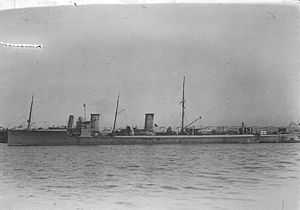Battle of Odessa (1914)
| Battle of Odessa | |||||||
|---|---|---|---|---|---|---|---|
| Part of World War I | |||||||
 The Ottoman destroyer Muavenet-i Milliye during the war | |||||||
| |||||||
| Belligerents | |||||||
|
|
| ||||||
| Commanders and leaders | |||||||
|
|
| ||||||
| Strength | |||||||
| 2 destroyers |
1 minelayer 2 gunboats | ||||||
| Casualties and losses | |||||||
| unknown |
1 minelayer sunk 1 gunboat sunk 1 gunboat damaged | ||||||
| |||||||
| ||||||
- For the battle at Odessa in 1941 see Siege of Odessa (1941).
The Battle of Odessa was an Ottoman naval attack against the Russian held port of Odessa, Ukraine in October 1914. At the time of battle the Ottoman Navy had just launched a major raid into the Black Sea to destroy the Russian Black Sea Fleet and to attack targets on land. In response to the raid Russia declared war on the Ottomans on November 1, 1914.
Battle
The overall raid was led by former German Mediterranean Squadron commander Admiral Wilhelm Souchon who was appointed to lead the Ottoman Navy in August 1914. With a force of three battlecruisers, two cruisers, four destroyers and two minelayers, the admiral entered the Black Sea on October 27 with the objective of attacking Russian naval bases before engaging the main Russian fleet if a favorable opportunity presented itself. Several attacks were made on various locations. Souchon sent the German built destroyers Gayret-i Vataniye and Muavenet-i Milliye under Commander Ayasofyali Ahmet and Ahmet Saffet to attack Odessa. The two vessels entered the port area at around 3:00 am on October 29 where they encountered three Russian warships and four merchant ships. Russian forces included the two gunboats Kubanets, Donets and the minelayer Beshtau.

The following engagement was the first action of the raid. Gayret-i Vataniye and Muavenet-i Milliye attacked the Donets first with their guns and when close enough the Gayret-i Vataniye let loose a couple of torpedoes. One struck the 1,200 ton Donets and she quickly sank (but was raised later in the war). Kubanets was engaged next and she fled after being struck several times by Ottoman gunfire along with the four Russian commercial steamers. The last Russian warship involved was the minesweeper, which was attacked by gunfire and sank after burning for a while. Following the naval skirmish the two destroyers began bombarding the city. For an hour the two Ottoman vessels fired, causing heavy damage without resistance. They then left Odessa before 5:00 am, and regrouped with one of the minelayers which laid mines off Ochakiv, sailing back to Istanbul.
Aftermath
Russian casualties are unknown but were heavy while the Ottomans suffered minimal if any damage. The Russians reported the attack to the garrison of Sevastopol who immediately prepared for an attack there. Coastal batteries were manned and a small squadron of one minelayer and a few gunboats was deployed. At about 5:00 am on October 29, Admiral Souchon reached Savastopol for a bombardment. The Russian shore batteries were capable of defending the city and repulsed the Ottoman attack, so Souchon chose to flee. When he reentered Ottoman waters he met and engaged the Russian squadron and forced them to retreat after heavily damaging the lead ship. The ports of Feodosiya and Novorossiysk were also attacked as part of the raid and mines were laid in the Kerch Strait.
Order of Battle
Ottoman Navy:
- Gayret-i Vataniye, destroyer, flagship
- Muavenet-i Milliye, destroyer
Russian Navy:
- Beshtau, minelayer, flagship
- Kubanets, gunboat
- Donets, gunboat
See also
- Mediterranean naval engagements during World War I
- Naval warfare of World War I
Footnotes
References
- Fromkin, David, A Peace to End All Peace: The Fall of the Ottoman Empire and the Creation of the Modern Middle East, Owl Books New York (2001), ISBN 0-8050-6884-8, pg.# 227
- Halpern, Paul G., A Naval History of World War I, Routledge New York (1994), ISBN 1-85728-498-4, pg.# 248
- Herlihy, Patricia, Odessa: A History, 1794–1914. Harvard University Press (1987). ISBN 0-916458-15-6, pg.# 507-509